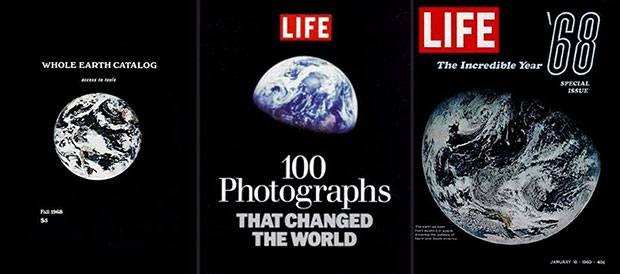Spaceship Earth: The Bigger Picture
 |
| First Whole Earth Catalog Cover 1968; Life: '100 Photographs That Changed The World' cover 2003; Life Special Issue January 1968 featuring Apollo 8 photograph. |
In 1969, the inventor and futurist Buckminster Fuller published a striking metaphor for a new ideal of planetary management in a book entitled Operating Manual for Spaceship Earth. Fuller famously proclaimed, "We are all astronauts," and argued that techniques developed for managing life in space should be transferred and applied to globally scaled environmental problems on Earth. "We are not going to be able to operate our Spaceship Earth successfully nor for much longer unless we see it as a whole spaceship and our fate as common. It has to be everybody or nobody."
More books followed -- like The Closing Circle (1971) in which Barry Commoner declared his famous four ecological laws, The Limits to Growth (1972) or Only One Earth: The Care and Maintenance of a Small Planet (1972) -- to tackle the big question of what would be required for humanity to continue to thrive.
Former NASA employee James Lovelock and biologist Lynn Margulis released the Gaia Hypothesis in 1974, a piece that proposed to look at planet Earth as a living organism, an integrated entity with interlinking geological and biological processes. Despite the initial resistance from the scientific community, the Gaia hypothesis generated many thought-provoking questions and helped to stimulate a holistic approach to studying Earth.
With intellectual audacity, the authors of these books on sustainability at the time were all big-picture, interdisciplinary thinkers. They offered a path-breaking analysis of the challenge of raising living standards for the poor without degrading the environment.
Developed nations needed to acknowledge the damage that they were inflicting on the biosphere and accept that their fate was inseparable from the prospects of the rest of the world. It was clear that many environmental threats were global; planetary interdependence had to become a moral and political reality, not just a hard and inescapable scientific fact.




0 Comments